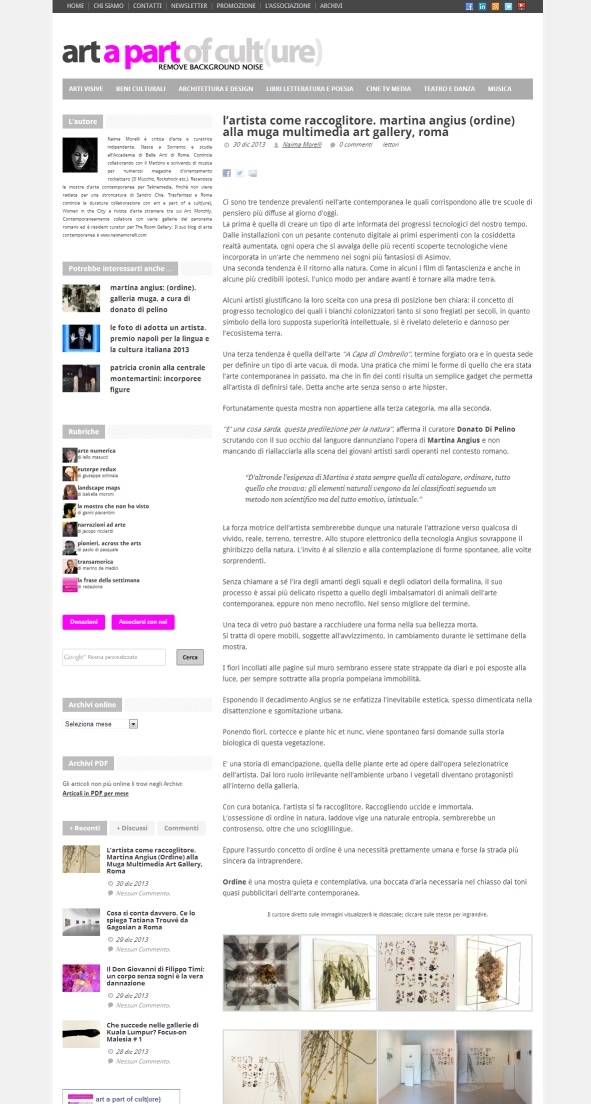
The Italian web magazine Art a Part of Cult(ure) has just published my review of Martina Angius’ exhibition “Ordine” curated by Donato Di Pelino at Muga Gallery, Rome.
Read More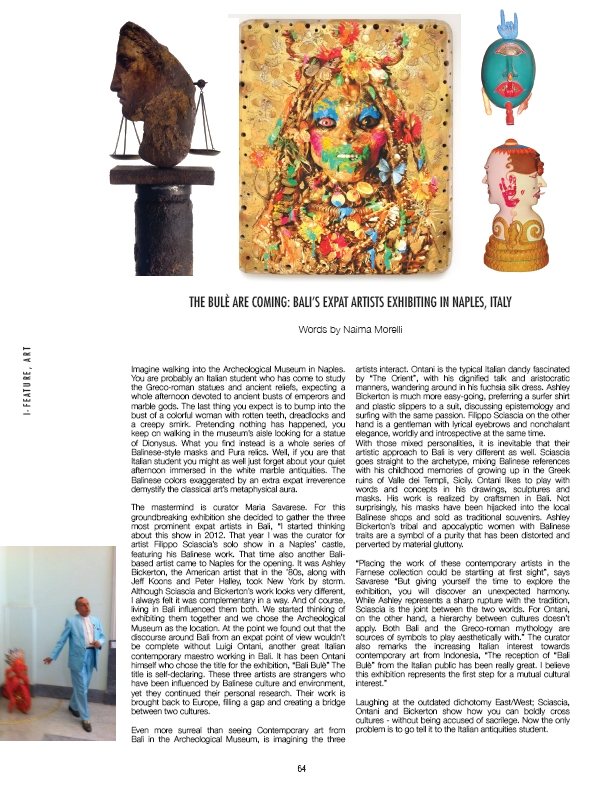
The Indonesian magazine I Magazine Bali has just published my review of the Bali Bulè exhibition at Museo Archeologico in Naples, featuring artists Bickerton, Ontani and Sciascia.
Here the link to the magazine website
Read More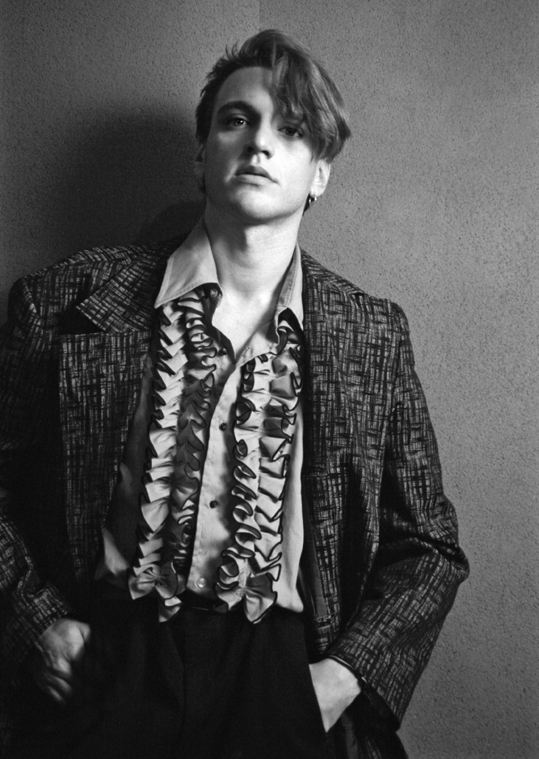
If you think that in the eighties in Italy there were just Loredana Bertè, Donatella Rettore and the Diaframma to dress weirdly, you are wrong. The eighties in Italy were truly rad. (If you are not Italian there are good chances you never hear of Loredana Bertè, Donatella Rettore and especially the Diaframma).
Anyways, if you have any doubt about the radness of the eighties in Italy, you should check st. foto libreria galleria, ironically just two steps away from the Vatican. You will be surprised to know that all the people looking at you from the pictures on the wall were actually everyday roman people, except that by night they transformed into dark eighties rockers.
The photographic work of Dino Ignani is anthropological. The portraits are almost segnaletic pictures, with a neutral background and no particular choice of light or pose.
He was “archiving” the underground dark scene of Rome. All these young people were photographed in roman discos and they dressed up for the occasion.
“It was startling to see all these people coming at the opening of the exhibition” said curator Paola Paleari ” you can tell that there were the same people of the pictures, but they look cleaned up from that dark look and even their attitude was different”.
It was an interesting choice from the st gallery to cover this less-known period of the Italian recent history, focusing on that particular community. For some it would be nostalgia, for some others even inspirational. Eighties are back.
Read More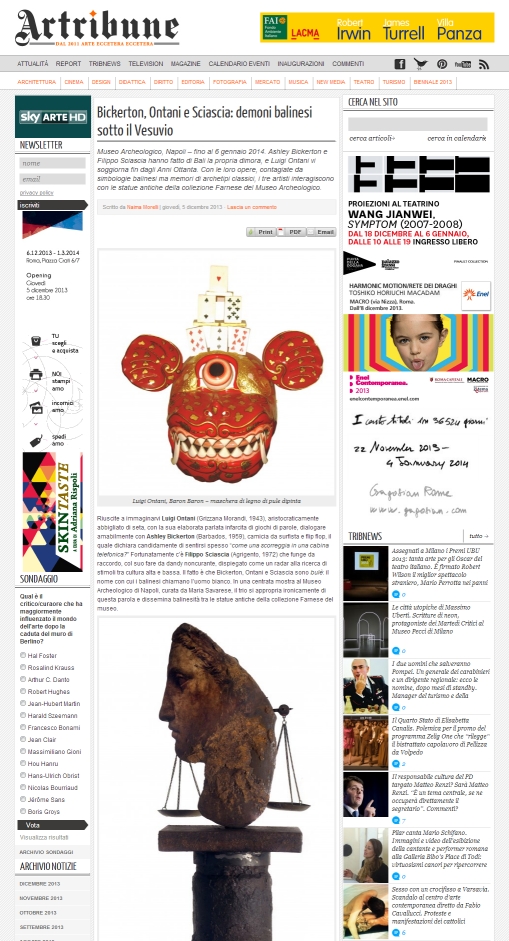
The Italian magazine Artribune has just published my review of the Bali Bulè exhibition at Museo Archeologico in Naples, featuring artists Bickerton, Ontani and Sciascia.
Read More
The Australian magazine Trouble has just published the interview I had in Perth with artist Tarryn Gill. The interview is part of my reportage about the Perth Art Scene.
Here the link to the interview
Here the link to the online version of the magazine
Read More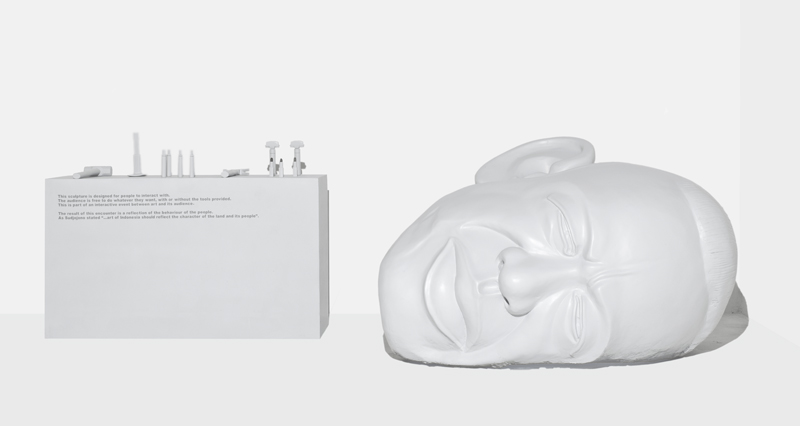
I met Marco Cassani in Bali during my reportage about contemporary art in Indonesia. What supposed to be an interview has become a lively chat about Marco’s art, hallucinogenic experiences and, of course, Bali. A month ago he sent me this mail about his new work that is going to be exhibit at “Imagining Indonesia, Tribute to S.Sudjojono” on the 23rd of November at Tonyraka Gallery in Bali:
Dear Naima,
How are you?
I am sending you the picture of my new work for the group exhibition
Tribute to Sudjojono at Tonyraka gallery on November, 23rd.
The work, entitled ‘CHANCE Project 2, Tribute to S. Sudjojono’, consists in:
1) a sculptor that represents the Sudjojono head (cement, 140 x 90 x 90 cm)
2) a box (wood, 120 x 70 x 45 cm) with a text (“This sculpture is designed
for people to interact with. The audience is free to do whatever they
want, with or without the tools provided. This is part of an interactive
event between art and its audience. The result of this encounter is a
reflection of the behaviour of the people. As Sudjojono stated Еarth of
Indonesia should reflect the character of the land and its people.”)

Since no one cares about the 55th Venice Biennale anymore, I feel like sharing my definitive thoughts about my favourite pavilion, without anyone there to contradict me.
So, chart lovers, my favourite pavilion was the Indonesian one, curated by Rifky Effendy.
In no other pavilion the installations of different artists work so perfectly together. The show almost looked like one single artist and yet it encapsulated such a richness of discourses.
If you were at the Venice Biennale in October, you would have seen me wandering in the Arsenal looking for the Indonesian Pavillion.
I actually overshot the main entrance, so I came in by the back door.
It was dark inside, and there was a soft music that I didn’t notice in the first place. The music though ended up being a background noise influencing the entire experience of the pavilion.
The soundscape was actually by Solo composer Rahayu Supanggah, the guy who reinvented traditional Indonesian music. For the Biennale’s composition he was inspired by the theme of the pavilion, which was “Sankti”.
As the press release stated, Sankti is a sanskrit word that refers to the primordial cosmic energy and the personification of the divine, feminine creative energy, as well as indicating change and liberation.
The first dark-metal work I encountered immediately struck me with his expressive power.
A group of man wearing a Muslim hat were sitting at a table. One man was laying with his head on the table, like someone who had been shot or something. One man was pointing his finger to another gentleman, who looked baffled. If you looked better at these two figures and you would notice that their legs where stretched under the table so to touch each other.
But the figure that really stood out was a matriarch in traditional clothes, upright at the end of the table. She was bringing a hand at his chest like saying: “Who, me?”
A weird lamp was falling from the ceiling, almost touching the table. It was shaped like something between an octopus and a tropical fruit.
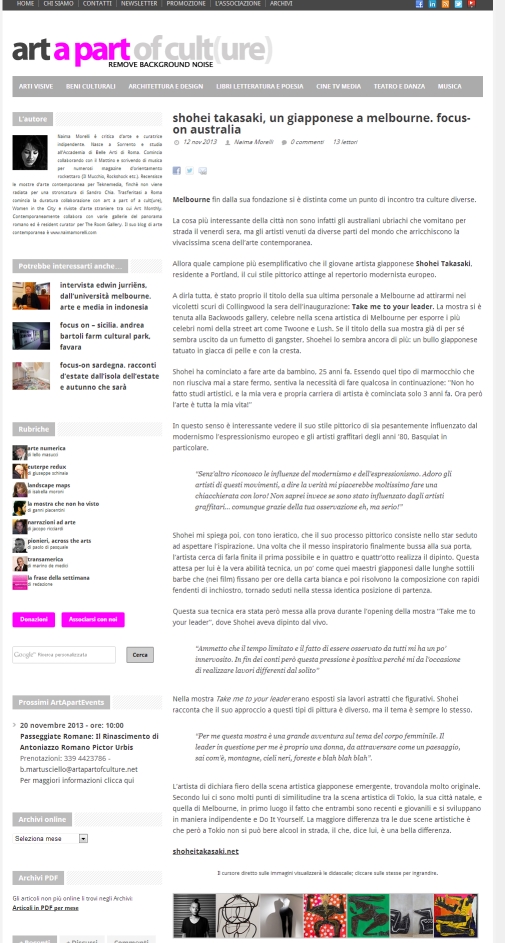
The Italian web magazine Art a Part of Cult(ure) has just published my interview with the Japanese artist Shohei Takasaki. The interview is part of my reportage about emerging artists in Melbourne.
Here the link to the interview
Read More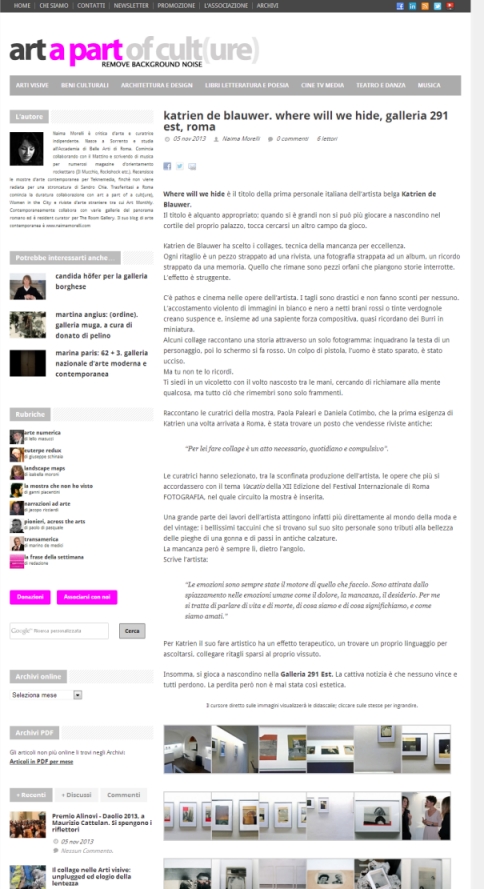
The Italian web magazine Art a Part of Cult(ure) has just published my review of the Katrien de Blauwer’s exhibition “Where will we hide” at Galleria 291 est, Rome.
Here you are the link to the review
Read More
My article “An artist in a waitress’s body” is in the November issue of Art Monthly Australia. The article features interviews with artsHub director Deborah Stone and artists Georgina Lee and Boe-Lin Bastian. The interview is part of my reportage about emerging artists in Melbourne.
Here the link to the Art Monthly Au website
Read More
“The Act of Killing” is the kind of movie that shuts you up for at least fifteen minutes after the credits. It makes you so uncomfortable that you can just chatter about irrelevant stuff with your friends out of the cinema.
Then, on the tram the way home, you suddenly burst in wordiness.
What happened is that “The Act of Killing” has finally been screened in Italian cinemas.
I went to see it the other day with a group of friends at the “Cinema Aquila”, in Pigneto, Rome.
The Act of Killing is an unconventional documentary film directed by Joshua Oppenheimer.
The film deals with the systematic slaughter of real or supposed communists in the aftermath of a failed coup in 1965 that led to General Suharto assuming power.
The director was not interested in gave a full picture of the historical events though. He didn’t even mention Suharto once.
The documentary revolves instead around the character of Anwar Congo, a leader of paramilitary organisation Pancasila Youth, whose job was to kill prisoners.
Because the historical picture was only hinted, I wouldn’t say it is a movie specifically about Indonesia’s ’65.
I would rather say it’s a movie about “the act of killing” itself, the psychology of the killer and the banality of evil.